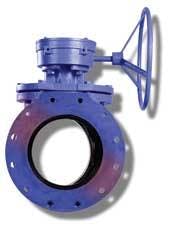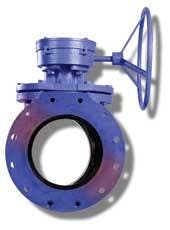Eccentric plug valves are used extensively in wastewater treatment plants because of their robust design and the ability to provide tight shutoff even in applications that contain high concentrations of solid waste material. At WEFTEC ‘07, the Henry Pratt Co will display its plug valves, available in sizes ½" through 36".
Eccentric plug valves were originally developed for use in paper mills. The plug valve was used in slurry lines in the mills for many years until eventually a lower cost valve replaced it. In 1952 the first eccentric plug valve was installed in a wastewater treatment plant and today the plug valve is the valve of choice for wastewater treatment plants and transmission lines.
The eccentric plug valve is favored over other valves because it has the ability to operate properly for many years even in solutions that contain high solids content. One of the key features in the Pratt plug valve is a 95% nickel body seat to provide a corrosion resistant seating service that can withstand years of punishment in unforgiving conditions. The plug is either fully encapsulated in rubber or has a rubber facing to insure bubble tight shut off and resistance to corrosion. Most plug valves are furnished with stainless steel bearings that give the valve lower bearing torques, but the bearings are durable enough to survive the constant abrasion of grit and solids within the system.
In a waste water transmission line, eccentric plug valves provide tight closure when the line needs to be shut down. The valves are typically shipped as either flanged or mechanical joint end valves and are equipped with a buried service manual worm gear. In most installations the valves are direct buried into the ground and cycled only a few times a year.
In a wastewater treatment plant, most eccentric plug valves are manually actuated and are either in the fully open or fully closed position. Smaller diameter valves (6" and smaller) can be furnished with a direct nut actuator that is operated by a removable lever. On larger valves, a manual worm gear operates the valves. Most in-plant valves are flanged end, but in some instances grooved end and/or mechanical joint valves have been furnished.
American Water Works Association recently published a new standard for the eccentric plug valve. The new standard (AWWA C517-05) outlines minimum requirements for companies that manufacture eccentric plug valves. This standard was written by a group of valve manufacturers, end users, and consulting engineers; all of whom have experience either designing systems, manufacturing eccentric plug valves or operating plug valves within their system. Some of the key requirements in the standard include proof of design testing, leak testing before shipment, materials of construction and installation recommendations to give advice to contractors and/or end users.
The Pratt plug valve fully meets AWWA C517-05 and each valve is leak tested at full rated pressure before shipment as required by AWWA. This reduces problems during installation and gives the end user peace of mind about the quality of the valve being installed in their system.
One of the key design features of the Pratt design is a round port (up through 20" diameter) which gives the valve lower headloss than most other competitive designs. The round port allows for higher flows and reduces the chance for clogging in wastewater applications.
The Henry Pratt Company designs, develops, manufactures and markets butterfly, rectangular, ball, nuclear, industrial, cone, check, sleeve, and energy dissipating valves as well as valve actuators and control systems. Its products are used in potable water, wastewater, power, industrial, and nuclear markets.




